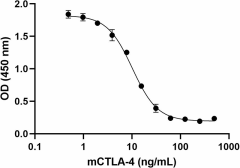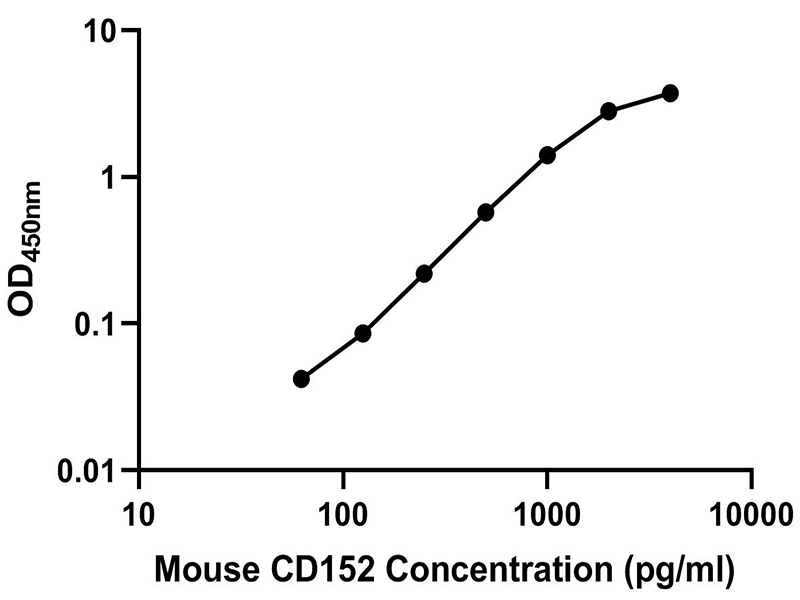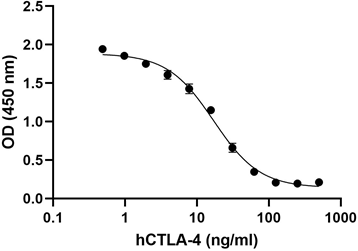- Regulatory Status
- RUO
- Other Names
- CD152, Ly-56
- Ave. Rating
- Submit a Review
- Product Citations
- publications

-

Recombinant mouse CTLA-4 inhibits the production of IL-2 induced by 0.5 µg/mL of CD80 on Jurkat cells in a dose-dependent manner. The ED50 for this effect is 5 - 30 ng/mL.
Mouse CTLA-4 was initially identified by differential screening of a murine cytolitic cDNA library. It is a member of the IgG superfamily, and it encodes a 223 amino acid protein and possesses a single extracellular V domain, a transmembrane domain, and a cytoplasmic domain. CTLA-4 is ~30% homologous with CD28, and both bind to the same ligands (B7.1/CD80 and B7.2/CD86) although CTLA-4 binds with higher affinity than CD28. Parallel recognition of a specific MHC-peptide complex by the T-cell receptor and CD80 or CD86 by the costimulatory receptor CD28 results in T-cell activation, cytokine production, proliferation, and differentiation. After the T cells' activation process and upregulation of CTLA-4, co-ligation of the TCR to MHC-peptide complex and CTLA-4 to its ligands results in cell cycle arrest and the end T cell activation. It has been suggested that the negative regulatory mechanism of CTLA-4 is mediated through trans-endocytosis of CD80 and CD86 (capture of ligands from opposing cells). The ligands are removed from the original cell and degraded inside of CTLA-4-expressing cells. As a result, the action of CD28 is impaired. Alternative splice variants of CTLA-4 have been described in mice and humans; these variants skip exon 2 (ligand-binding domain) or exon 3 (transmembrane domain). The ligand independent CTLA-4 is expressed in mice, but not in humans, and the soluble CTLA-4 (sCTLA-4) is expressed in mice and humans. CTLA-4 is constitutively expressed by Tregs, and they are an important source of sCTLA-4. It has been suggested that sCTLA-4 potentiates regulatory T cell function. High levels of sCTLA-4 in Tregs have been associated with type 1 diabetes (T1D) and other autoimmune diseases.
Product DetailsProduct Details
- Source
- Mouse CTLA-4, amino acids (Ala37-Phe162) (Accession# AAH42741), was expressed in CHO cells, with Human IgG-Fc and a 6His-tag at the carboxy terminus.
- Molecular Mass
- The 366 amino acid recombinant protein has a predicted molecular mass of approximately 41 kD. The DTT-reduced and non-reduced glycosylated protein migrate at approximately 55 kD and 110 kD respectively by SDS-PAGE. The predicted N-terminal amino acid is Ala.
- Purity
- >95%, as determined by Coomassie stained SDS-PAGE.
- Formulation
- 0.22 µm filtered protein solution is in PBS.
- Concentration
- 10 and 25 µg sizes are bottled at 200 µg/mL. 100 µg size and larger sizes are lot-specific and bottled at the concentration indicated on the vial. To obtain lot-specific concentration and expiration, please enter the lot number in our Certificate of Analysis online tool.
- Storage & Handling
- Unopened vial can be stored between 2°C and 8°C for up to 2 weeks, at -20°C for up to six months, or at -70°C or colder until the expiration date. For maximum results, quick spin vial prior to opening. The protein can be aliquoted and stored at -20°C or colder. Stock solutions can also be prepared at 50 - 100 µg/mL in appropriate sterile buffer, carrier protein such as 0.2 - 1% BSA or HSA can be added when preparing the stock solution. Aliquots can be stored between 2°C and 8°C for up to one week and stored at -20°C or colder for up to 3 months. Avoid repeated freeze/thaw cycles.
- Activity
- Recombinant mouse CTLA-4 inhibits the production of IL-2 induced by 0.5 µg/mL of CD80 on Jurkat cells in a dose-dependent manner. The ED50 for this effect is 5 - 30 ng/mL.
- Application
-
Bioassay
- Application Notes
-
BioLegend carrier-free recombinant proteins provided in liquid format are shipped on blue-ice. Our comparison testing data indicates that when handled and stored as recommended, the liquid format has equal or better stability and shelf-life compared to commercially available lyophilized proteins after reconstitution. Our liquid proteins are verified in-house to maintain activity after shipping on blue ice and are backed by our 100% satisfaction guarantee. If you have any concerns, contact us at tech@biolegend.com.
- Product Citations
-
Antigen Details
- Structure
- Homodimer
- Distribution
-
Activated T cells, CD4, CD8, and Tregs
- Function
- Inhibits T cell activation by reducing IL-2 production and IL-2R expression, also arresting T cells in G1 phase of the cell cycle; protects against the development of autoimmunity
- Interaction
- Antigen presenting cells, B cells
- Ligand/Receptor
- CD80 (B7.1), CD86 (B7.2)
- Biology Area
- Immunology, Inhibitory Molecules
- Molecular Family
- CD Molecules, Immune Checkpoint Receptors, Soluble Receptors
- Antigen References
-
1. Linsley PS, et al. 1991. J. Exp. Med. 174:561.
2. Pentcheva-Hoang T, et al. 2004. Immunity 2:401.
3. Qureshi OS, et al. 2011. Science 332:600.
4. Gerold KD, et al. 2011. Diabetes 60:1955.
5. Ryden A, et al. 2012. Diabetes Metab. Res. Rev. 28:84.
6. Mittal AK, et al. 2013. PloS One 8:e70352.
7. Ward FJ, et al. 2013. Eur. J. Immunol. 43:1274. - Gene ID
- 12477 View all products for this Gene ID
- UniProt
- View information about CTLA-4 on UniProt.org
Related FAQs
- Why choose BioLegend recombinant proteins?
-
• Each lot of product is quality-tested for bioactivity as indicated on the data sheet.
• Greater than 95% Purity or higher, tested on every lot of product.
• 100% Satisfaction Guarantee for quality performance, stability, and consistency.
• Ready-to-use liquid format saves time and reduces challenges associated with reconstitution.
• Bulk and customization available. Contact us.
• Learn more about our Recombinant Proteins. - How does the activity of your recombinant proteins compare to competitors?
-
We quality control each and every lot of recombinant protein. Not only do we check its bioactivity, but we also compare it against other commercially available recombinant proteins. We make sure each recombinant protein’s activity is at least as good as or better than the competition’s. In order to provide you with the best possible product, we ensure that our testing process is rigorous and thorough. If you’re curious and eager to make the switch to BioLegend recombinants, contact your sales representative today!
- What is the specific activity or ED50 of my recombinant protein?
-
The specific activity range of the protein is indicated on the product datasheets. Because the exact activity values on a per unit basis can largely fluctuate depending on a number of factors, including the nature of the assay, cell density, age of cells/passage number, culture media used, and end user technique, the specific activity is best defined as a range and we guarantee the specific activity of all our lots will be within the range indicated on the datasheet. Please note this only applies to recombinants labeled for use in bioassays. ELISA standard recombinant proteins are not recommended for bioassay usage as they are not tested for these applications.
- Have your recombinants been tested for stability?
-
Our testing shows that the recombinant proteins are able to withstand room temperature for a week without losing activity. In addition the recombinant proteins were also found to withstand four cycles of freeze and thaw without losing activity.
- Does specific activity of a recombinant protein vary between lots?
-
Specific activity will vary for each lot and for the type of experiment that is done to validate it, but all passed lots will have activity within the established ED50 range for the product and we guarantee that our products will have lot-to-lot consistency. Please conduct an experiment-specific validation to find the optimal ED50 for your system.
- How do you convert activity as an ED50 in ng/ml to a specific activity in Units/mg?
-
Use formula Specific activity (Units/mg) = 10^6/ ED50 (ng/mL)
 Login / Register
Login / Register 














Follow Us